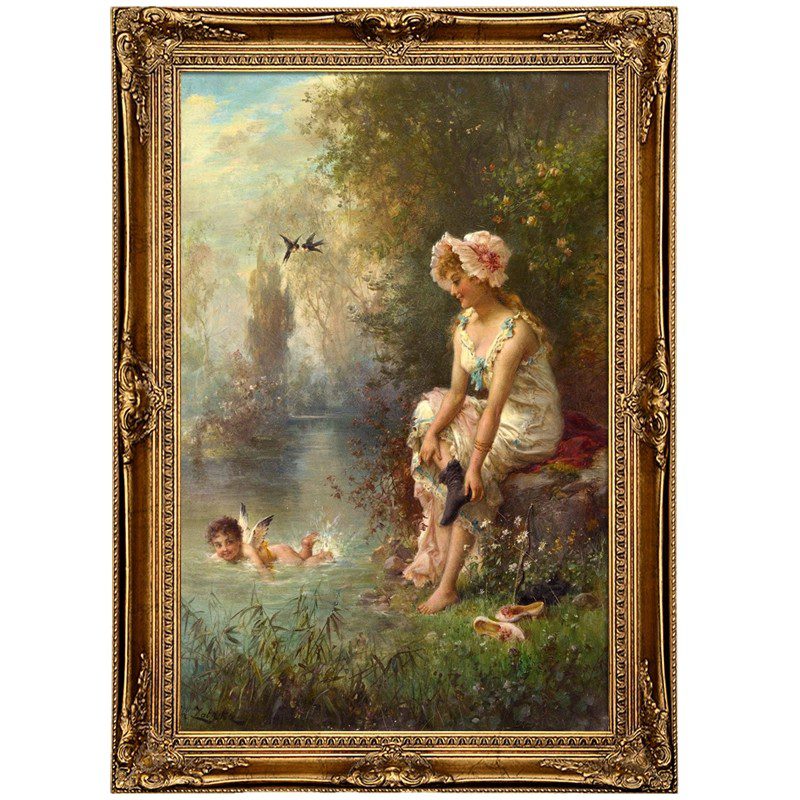Key Characteristics of Hand-Painted Oil Art with Potential for Appreciation
Collectors and investors often seek hand-painted oil art that not only resonates aesthetically but also holds long-term value. While market trends fluctuate, certain attributes consistently signal an artwork’s potential to appreciate over time. These include the artist’s reputation, technical mastery, historical relevance, and uniqueness. Below, explore the defining features that contribute to an oil painting’s升值潜力 (appreciation potential), focusing on factors that transcend fleeting trends and align with enduring cultural and artistic significance.
1. Artist’s Recognition and Trajectory: Emerging Talent vs. Established Names
The artist’s standing in the art world is a primary indicator of a painting’s future value. Works by established artists with a documented history of exhibitions, critical acclaim, or institutional recognition (e.g., gallery representation, museum acquisitions) often retain or increase their worth due to sustained demand. However, emerging artists whose styles, themes, or techniques show innovation or alignment with evolving cultural movements can also offer significant appreciation potential.
For emerging talents, look for signs of early recognition, such as awards, residencies, or inclusion in curated group shows. Artists who consistently refine their practice, engage with pressing social or philosophical themes, or develop a distinct visual language are more likely to gain prominence. Additionally, track their participation in art fairs, biennials, or online platforms dedicated to discovering new voices, as these venues often serve as launchpads for careers.
2. Technical Mastery and Originality: Skill That Transcends Imitation
Oil paintings that demonstrate exceptional technical skill—such as precise brushwork, layered glazes, or innovative use of materials—are more likely to be valued by collectors and institutions. Mastery of traditional techniques, combined with a willingness to experiment, signals an artist’s dedication to their craft. For example, paintings that employ complex color harmonies, dynamic compositions, or textural depth often stand out for their visual and emotional impact.
Originality is equally critical. Artworks that challenge conventions, reinterpret historical styles, or introduce novel subject matter are more memorable and harder to replicate, enhancing their desirability. Avoid generic or derivative works, even if they are technically proficient, as these are less likely to generate sustained interest. Instead, prioritize paintings that reflect the artist’s unique perspective, whether through abstract expression, surreal imagery, or hyperrealistic detail.
3. Historical and Cultural Relevance: Context That Amplifies Significance
Artworks tied to specific historical moments, social movements, or cultural shifts often gain relevance over time, especially as new generations reinterpret their meanings. For instance, paintings that address themes like climate change, identity politics, or technological disruption may become increasingly significant as these issues dominate global discourse. Similarly, works created during periods of artistic innovation (e.g., the Renaissance, Abstract Expressionism) often appreciate due to their role in shaping art history.
Cultural context also matters. Paintings that reflect regional traditions, folklore, or underrepresented narratives can attract attention as collectors seek to diversify their holdings. Research the artist’s background, influences, and the era in which the work was created to understand its broader significance. Artworks with clear documentation—such as exhibition history, artist statements, or critical reviews—are easier to authenticate and contextualize, further boosting their appeal.
4. Provenance and Documentation: Transparency That Builds Trust
A well-documented provenance, or history of ownership, adds credibility and value to an oil painting. Artworks with clear records of past exhibitions, sales, or conservation efforts are less likely to face disputes over authenticity or legitimacy, making them more attractive to buyers. Provenance can include certificates of authenticity, gallery receipts, exhibition catalogues, or appraisals from recognized experts.
For contemporary works, ensure the artist or their estate has issued a certificate of authenticity, which verifies the work’s origin and materials. If purchasing from a secondary market, request detailed documentation of the painting’s journey, including any restoration or conservation treatments. Artworks with gaps in their provenance may be undervalued initially but could face challenges reselling later, as collectors prioritize transparency and risk mitigation.
5. Condition and Rarity: Physical Integrity and Scarcity
The physical state of an oil painting significantly impacts its appreciation potential. Paintings free from cracks, fading, or structural damage (e.g., warped canvas, loose stretcher bars) are more likely to retain their value, as restoration costs can be prohibitive. Regular maintenance, such as proper storage, climate control, and gentle cleaning, helps preserve an artwork’s condition over time.
Rarity also plays a role. Limited editions, one-of-a-kind pieces, or works from an artist’s lesser-known period are often more sought after than mass-produced or repetitive motifs. For example, a painting created during an artist’s experimental phase may be rarer and more intriguing than their later, more commercial output. Similarly, artworks that were part of a small series or commissioned for a specific purpose (e.g., a private collection, public installation) can carry additional historical weight.
The appreciation potential of hand-painted oil art hinges on a combination of artistic merit, cultural relevance, and market dynamics. By prioritizing works with strong technical foundations, documented histories, and connections to broader narratives, collectors can build portfolios that resonate both aesthetically and financially. While no artwork is guaranteed to increase in value, those that embody originality, skill, and contextual depth are better positioned to endure as cultural and economic assets.
